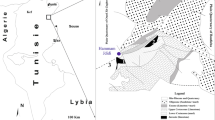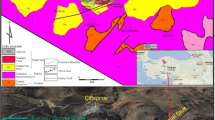Abstract
Well-preserved tufa deposits exhibit a diversity of field fabrics along the major structural feature in Gafsa area and extent between Jebel El Mida in the southeast and Sidi Ahmed Zarrouk and Jebel Ben Younes in northwest. The deposition history of the tufa is defined by three major stages; the first occurred in a perched springline or slope system with dominance of the autochthonous facies (stromatolitic tufa facies, i.e. boundstone sheets of micrite and peloids, and phytoherm framestone facies) in the proximal zone and microdetrital tufa in distal sites. The second stage occurred in a mixture of perched springline and poorly drained paludal environments that characterized by the abundance of allochems and chalk and marl. The third deposition stage occurred in a mixture of paludal and braided fluviatile environments with allochthonous tufa facies (oncoidal cyanolith tufa facies, phytoclast tufa facies and lithoclast and intraclast tufa facies). Tufas are of particular interest since their occurrences are linked to tectonic activity and extensional fault systems. Gafsa strike-slip fault, in addition to its tectonic role in creating fluid paths to the surface through flowing springs, it acts as a major regional sill that controlled paleoflow directions, discharge locations, volume, rate and fluctuations of the water supply. Tufa cessation could be explained by increasing aridity during late Holocene and subsequent reduced rainfall, increased evaporation and water table falling, which reduce the amount of recharge and its subsequent dissolution in the recharge area.










Similar content being viewed by others
References
Alçiçek MC, Özkul M (2005) Extensional faulting induced tufa precipitation in the Neogene Cameli Basin of south-western Anatolia, Turkey. In: Özkul, M., YAgiz, S. & Jones, B. (eds) travertine, Proceedings of 1st International Symposium on travertine. Denizli, Turkey. Kozan ofset, Ankara, 120–127
Belgacem Ch (1988) Fonctionnement hydraulique du seuil de Gafsa. Mém. de DEA, Facult Sci Tunis. 120 p
Bonvallot J, Miossec A (1985) Le Quaternaire moyen de la Tunisie: Un essai de synthese. Physio-Géo 14(15):139–148
Bouri S, Ben Dhia H (2008) Hydrothermalisme en Tunisie : potentiel et prospectives. Forum de l’Eau, 16 et 17 avril 2008, Gabès, Tunisie. p. 28–34
Brogi A, Cappezuoli E, Buracchi E, Branca M (2012) Tectonic control on travertine and calcareous tufa deposition in a low-temperature geothermal system (Sarteano, Central Italy). J Geol Soc London 169:461–476
Burollet PF (1956) Contribution à l’étude stratigraphique de la Tunisie centrale. Thèse Doct. Es Sciences, Paris. Ann Mines Geol Tunis, 350 p
Caine JS, Evans IP, Forster CB (1996) Fault zone architecture and permeability structure. Geology 24:1025–1028
Castany G (1950) Les seuils hydrauliques de Tunisie. Etudes géologique, géophysique et hydrologique. Le seuil de Gafsa. Ann Mines et Géol Tunis 6:120–160
Castany G (1953) Orogenèse Quaternaire dans la région de Gafsa. Bull Soc Sci Nat de Tunisie 6:151–160
Chafetz HS, Folk RL (1984) Travertines: depositional morphology and the bacterially constructed constituents. J Sediment Petrol 54:289–316
Chafetz HS, Rush P, Utech NM (1991) Microenvironmental controls on mineralogy and habit of CaCO3 precipitates: an example from an active travertine system. Sedimentology 38:107–126
Edmunds WM, Guendouz AH, Mamou A, Moulla A, Shand P, Zouari K (2003) Groundwater evolution in the Continental Intercalaire aquifer of southern Algeria and Tunisia: trace element and isotopic indicators. Applied Geochim 18:805–822
Evans J (1999) Recognition and implications of Eocene tufas and travertines in the Chadron Formation, White River Group, Badlands of South Dakota. Sedimentology 46:771–789
Farhat H (1984) Carte des ressorces en eau souterraine à l’échelle 1 :200.000 : feuille de Gafsa. Direction des ressources en eau Gafsa. 29p
Farhat H, Moumni L (1989) Etude hydrogéologique de la nappe de Gafsa Nord. DGRE, Tunis. 25 pp
Ford TD, Pedly HM (1996) A review of tufa and travertine deposits of the world. Earth Sci Rev 4:117–175
Glover C, Robertson AHF (2003) Origin of tufa (cool-water carbonate) and related terraces in the Antalya area, SW Turkey. Geol J 38:329–358
Goudie AA, Viles HA, Pentecost A (1993) The Late Holocene tufa decline in Europe. Holocene 3:181–186
Julia R (1983) Travertines. In: P.A. Scholle, D.G. Bebout and C.H. Moore (Editors), Carbonate Depositional Environments. Am Assoc Petrol Geo Mem 33:64–72
Moumni L (1989) Contrôle de l’evolution piezometriique de la nappe de Gafsa Nord. Tunis, Rapp. Int., DGRE. 7 pp
Nishikawa O, Furuhashi K, Masuyama M, Ogata T, Shiraishi T, Shen CC (2012) Radiocarbon dating of residual organic matter in travertine formed along the Yumoto Fault in Oga Peninsula, northeast Japan: implications for long-term hot spring activity under the influence of earthquakes. Sediment Geol 243:181–190
Pedley HM (1990) Classification and environmental models of cool freshwater tufa. Sediment Geol 68:143–154
Pedley HM, Andrews J, Ordoñez S, Garcia Cura MA, Gonzalez Martin J, Taylor D (1996) Does climate control the morphological fabric of freshwater carbonates? A comparative study of Holocene barrage tufas from Spain and Britain. Palaeogeogr Palaeclim Palaeoecol 121:239–257
Pedley M, Martin GJA, Delgado SOM, Del Cura AG (2003) Sedimentology of Quaternary perched springline and paludal tufas: criteria for recognition, with examples from Guadalajara Province, Spain. Sedimentology 50:23–44
Ricolvi M (1976) Etude hydrogéologique de la nappe du crétacé inférieur de Gafsa. Document ARE. 26 p
Vaufrey R (1932) Les plissements Acheulo-Moustériens des alluvions de Gafsa. Rev Géogr Phys Géol Dyn 1:299–321
Viles HA, Goudie AS (1990) Tufas, travertines and allied carbonate deposits. Prog Phys Geogr 14:19–41
Yermani M (2002) Contribution à l’étude du fonctionnement hydrodynamique du système aquifère de Gafsa Nord (Tunisie centrale). Thèse Doctorat Univ. Tunis II. 213 p
Zargouni F, Ruhland M (1981) Style de déformations du Quaternaire récents liés au coulissement de la faille de Gafsa et chronologie des phases tectoniques de l’atlas méridionale de la Tunisie. CR Acad Sci Paris 292:913–915
Author information
Authors and Affiliations
Corresponding author
Rights and permissions
About this article
Cite this article
Henchiri, M. Sedimentology of Quaternary calcareous tufas from Gafsa, southwestern Tunisia. Arab J Geosci 7, 2081–2091 (2014). https://doi.org/10.1007/s12517-013-0909-2
Received:
Accepted:
Published:
Issue Date:
DOI: https://doi.org/10.1007/s12517-013-0909-2




